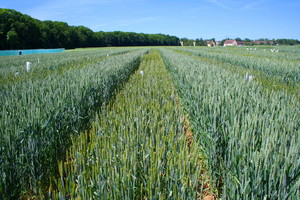General information about hybrid wheat
Hybrids were used in many crops and vegetables with big success. In contrast, less than 1 % of the world wheat production is with hybrids. Main reasons are the limited heterosis and especially the complicated hybrid seed production. Nevertheless, hybrid wheat is seen as one important pillar to feed the steadily growing human population. One important reason is the higher yield stability of hybrids compared to line or population varieties reported for maize and other crops. Facing climate change and the need to expand wheat production to more unfavorable regions, it is speculated that hybrids will cope with these inconveniences better than line varieties. For successful establishment of hybrid wheat, some major steps have to be realized. First, heterotic groups have to be found or artificially generated, second reliable, easy and stable sterility mechanisms have to be elaborated, third, pollination capability must be increased and finally best breeding schemes for hybrid wheat must be found. Together with Prof. Dr. J. Reif, we work intensively on the establishment of heterotic groups, the improvement of pollination capability and optimum breeding schemes using genomic selection. For instance, we performed until now the largest ever published survey on heterosis (HYWHEAT-project) in wheat with field trials at 11 locations of 1,604 hybrids and their 135 parental lines. In a follow-up project (ZUCHTWERT) involving Prof. Reif and all German wheat breeders, we even increased the number of parental elite lines, and hybrids and extended the search for heterotic groups also towards non-adapted and old lines. Some results were summarized on this page. Furthermore, we offer consulting to efficiently start into hybrid wheat breeding.

 Hybrid wheat production
Hybrid wheat production